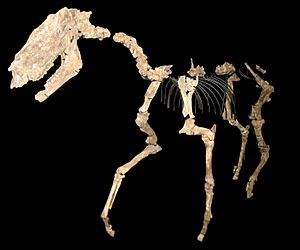Hipparion facts for kids
Quick facts for kids Hipparion |
|
|---|---|
 |
|
| H. laromae skeleton | |
| Scientific classification |
|
| Kingdom: | Animalia |
| Phylum: | Chordata |
| Class: | Mammalia |
| Order: | Perissodactyla |
| Family: | Equidae |
| Subfamily: | Equinae |
| Tribe: | †Hipparionini |
| Genus: | †Hipparion De Christol, 1832 |
| Species | |
|
See text |
|
| Synonyms | |
|
|
Hipparion (which means "pony" in Greek) was an extinct type of horse. It lived in many parts of the world, including North America, Asia, Europe, and Africa. These ancient horses lived a long time ago, from about 23 million years ago to 780,000 years ago. That's a huge span of 22 million years!
Unlike modern horses, Hipparion's feet had three small, extra toes. These toes were not used for walking, but they were still there, alongside its main hoof.
Contents
What Was Hipparion?
Hipparion was a genus of horse that roamed the Earth for millions of years. It was first described by Jules de Christol in 1832. These horses were an important part of ancient ecosystems across different continents.
Where Did Hipparion Live?
Hipparion was very successful and spread across the globe. Its fossils have been found in many places. This shows that it could adapt to different environments. It lived in North America, Asia, Europe, and Africa.
When Did Hipparion Live?
Hipparion lived during the Miocene and Pleistocene epochs. The Miocene epoch lasted from about 23 million to 5.3 million years ago. The Pleistocene epoch followed, from 2.6 million to 11,700 years ago. This means Hipparion was around for most of the Miocene and part of the Pleistocene. It finally died out around 780,000 years ago.
How Was Hipparion Different from Modern Horses?
The most interesting difference between Hipparion and today's horses is its feet. Modern horses have only one toe, which is covered by a hoof. Hipparion had a large central hoof, just like modern horses. But it also had two smaller, extra toes on each side. These extra toes were very small and did not touch the ground when the animal walked. They are called vestigial toes, meaning they were left over from earlier ancestors.
See also
 In Spanish: Hipparion para niños
In Spanish: Hipparion para niños

